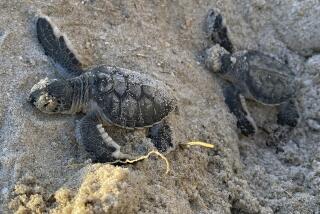Hospital puts sea turtles with tumors on fast track
- Share via
Reporting from Boca Raton, Fla. — The hospital waiting room was packed with patients, but not with humans. These were endangered green sea turtles covered with golf-ball-sized growths.
At least 40 scientists and veterinarians participated in delicate surgeries at the Gumbo Limbo Nature Center on Tuesday to remove noncancerous tumors, called fibropapilloma. The tumors, some of them on the turtles’ eyes, resembled moldy cauliflower.
Once the tumors are removed, some turtles will have a chance to regain lost sight.
“We kind of look at it like an alien abduction,” said Cody Mott, project manager at Gumbo Limbo in Boca Raton, Fla. “Somebody picks them up out of the water and takes them somewhere on a ship, and next thing you know, somebody is poking and prodding them. They’re probably not in the best moods to be here, but in the long run, it’s in their benefit. They do recover really well.”
The tumors have turned up in alarming numbers on sea turtles all over the world, and researchers are scrambling to find a cure. Most of Tuesday’s patients were brought in during Florida’s recent cold spell. Veterinarians became concerned after discovering that many of the 170 turtles were covered with tumors.
“A lot of these guys have these tumors all around their eyelids; on their eyeballs . . . and that can really compromise them out in the wild,” said Joshua Broadwater, an animal ophthalmologist who helped with the surgeries.
After technicians took blood pressure and other vital signs, an attendant wheeled the turtles downstairs to a makeshift operating room, where six teams of veterinarians administered anesthesia and put in breathing tubes.
They pumped air into the turtles’ lungs as machines monitored heart rate and blood pressure. The vets then used lasers to meticulously burn or cut the tumors from the turtles. Thirty-five of the creatures were scheduled for the procedure.
The turtles will be released to their natural habitat after two to four weeks of rehabilitation.
First observed in the late 1930s, fibropapilloma has reached epidemic proportions in Hawaii and Florida, said Jeanette Wyneken, an associate professor in the department of biological sciences at Florida Atlantic University.
The disease doesn’t affect humans, but attaches to loggerhead sea turtles and a variety of fish, marine conservationists say.
The prevalence of the tumors in turtles found in the Intracoastal Waterway lagoons leads many to suspect that they are caused by fertilizer or farm waste runoff.
“That’s one thing that we really want to see increase is more research on this disease,” said Dr. Kirt Rusenko, one of Gumbo Limbo’s marine conservationists. “We’re hoping our proximity to Florida Atlantic University will give researchers there the opportunity to take advantage of our patients that are here to try to find out what can be done to really cure this disease, or at least find out what causes it.
“We really need a lot of information,” he said. “There is so little known about this.”
More to Read
Sign up for Essential California
The most important California stories and recommendations in your inbox every morning.
You may occasionally receive promotional content from the Los Angeles Times.












